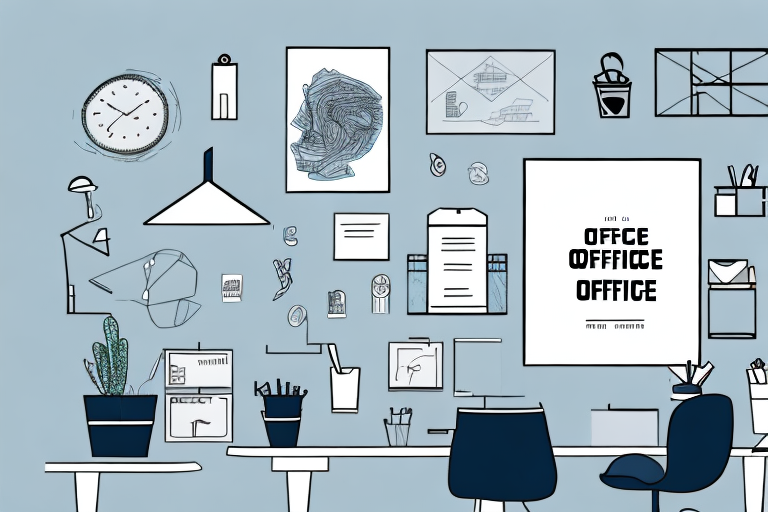
How to Create a Personalized Office Decor for Your Home or Business
Are you tired of drab and uninspiring workspaces? Do you want to boost productivity, creativity, and employee satisfaction through personalized office decor? Look no further! This guide will take you through the essential steps of creating an inspiring and functional office space that reflects your brand identity and meets your unique needs. From assessing your office space and needs to choosing a theme or color scheme, and selecting the right furniture and accessories, we’ve got you covered. So let’s get started!
Understanding the Importance of Personalized Office Decor
Creating an inspiring and personalized office decor is about more than just aesthetics. It can have a significant impact on your productivity, creativity, and employee satisfaction. Let’s explore some of the benefits:
Boosting Productivity and Creativity
A well-designed office space can help you focus better, stay organized, and feel motivated. When you enjoy the environment you’re working in, you’re more likely to be productive and creative. Personalized decor can also help you eliminate distractions and create a space that’s conducive to your work style.
For example, if you’re someone who works best in a minimalist environment, you can decorate your office with simple and clean lines. On the other hand, if you’re someone who thrives in a vibrant and colorful space, you can add pops of color to your decor to keep you energized throughout the day.
Additionally, adding plants to your office decor can help improve air quality and reduce stress levels. Studies have shown that being surrounded by greenery can increase productivity by up to 15%.
Reflecting Your Brand Identity
Your office decor is an extension of your brand identity. It can communicate your values, mission, and vision to clients, employees, and visitors. Whether you’re running a home-based business or a larger corporation, a personalized office space can create a memorable brand experience that sets you apart from the competition.
For instance, if you run a creative agency, you can decorate your office with unique artwork and furniture to showcase your creativity and innovation. If you’re a law firm, you can opt for a more traditional and professional decor to convey a sense of trust and reliability.
Enhancing Employee Satisfaction
Your office space can also have a significant impact on employee satisfaction and retention. When employees feel comfortable and inspired in the workplace, they’re more likely to be engaged, loyal, and motivated. Personalized decor can help you create a welcoming and supportive environment that promotes teamwork, creativity, and wellbeing.
You can involve your employees in the process of decorating the office to make them feel valued and heard. Allow them to personalize their workstations with photos, plants, or other items that bring them joy and inspiration. This will not only enhance their satisfaction but also foster a sense of ownership and pride in their work environment.
Moreover, you can add comfortable seating areas, breakout rooms, or even a game room to encourage socialization and relaxation. This will help your employees recharge and boost their creativity and productivity.
In conclusion, personalized office decor is not just a matter of aesthetics but a strategic tool to enhance productivity, creativity, and employee satisfaction. By creating a space that reflects your brand identity and supports your employees’ wellbeing, you can improve your business performance and stand out in the competitive market.
Assessing Your Office Space and Needs
The first step in creating a personalized office decor is assessing your office space and needs. Here are some essential factors to consider:
Evaluating the Available Space
Before you start decorating, it’s essential to assess the available space and determine how much of it you’ll need for your work activities. Consider the floor plan, the size of the room, the number of windows, doors, and electrical outlets, and any other architectural features that may influence your design choices.
For instance, if you have a small office space, you may need to prioritize functionality over aesthetics. You may need to invest in space-saving furniture, such as a foldable desk or a wall-mounted shelf, to maximize the available space. Alternatively, if you have a spacious office, you may have more freedom to experiment with different design elements, such as a statement wall or a bold color scheme.
Identifying Your Work Style and Requirements
Next, think about your work style and requirements. Do you need a quiet and private space to concentrate, or do you prefer an open and collaborative environment? What type of equipment, tools, and supplies do you need to perform your work activities? Who are your clients, visitors, and colleagues, and how will they use the office space?
For example, if you’re a writer or a programmer, you may need a quiet and distraction-free workspace. You may want to invest in noise-cancelling headphones or a soundproofing panel to minimize external noise. Alternatively, if you’re a graphic designer or an architect, you may need a large desk and a drawing board to sketch your ideas. You may want to prioritize ergonomics and invest in a comfortable chair and a footrest to prevent back pain and fatigue.
Considering the Needs of Your Team (if applicable)
If you’re running a business or managing a team, it’s crucial to consider their needs and preferences as well. What are their work styles, tasks, and requirements? How can you create a shared workspace that promotes communication, teamwork, and productivity?
For instance, if you have a sales team, you may want to create a common area where they can brainstorm ideas and share their success stories. You may want to provide a whiteboard, a projector, or a video conferencing system to facilitate their meetings and presentations. Alternatively, if you have a customer service team, you may want to create individual cubicles or booths to ensure privacy and minimize distractions. You may want to provide a headset, a phone, or a chat system to enable them to communicate with customers efficiently.
By considering these factors, you can create a personalized office decor that reflects your style, meets your needs, and enhances your productivity and well-being.
Choosing a Theme or Color Scheme
When you’re designing your office space, it’s important to choose a theme or color scheme that reflects your brand identity and meets your aesthetic preferences. But how do you choose the right colors and themes for your office? Here are some tips to help you get started:
Selecting Colors that Inspire and Motivate
Colors can have a significant impact on our mood, emotions, and behavior. When choosing a color scheme for your office, think about the kind of atmosphere you want to create. Do you want a calm and serene space, or a lively and energetic one?
Blues are often associated with calmness and relaxation, making them a great choice for offices where people need to focus and concentrate. Greens are known for their balancing properties, making them a good choice for spaces where people need to feel grounded and centered. Yellows are associated with energy and creativity, making them a great choice for spaces where people need to be inspired and motivated. And reds are often associated with passion and intensity, making them a good choice for spaces where people need to feel energized and driven.
Consider also the psychological effects of different colors on your clients, visitors, and colleagues. For example, if you’re designing a space for a healthcare provider, you might want to choose calming colors like blues and greens to help patients feel relaxed and at ease.
Incorporating Your Brand Colors
If you have a brand color scheme, consider incorporating it into your office decor to create a consistent and recognizable brand experience. This can help reinforce your brand identity and make your office feel more cohesive and professional.
Use your brand colors for walls, furniture, accessories, and signage, and make sure they complement each other and enhance your overall design. For example, if your brand colors are blue and green, you might choose a blue accent wall and green furniture to create a cohesive look.
Balancing Aesthetics and Functionality
When choosing a theme or color scheme, it’s important to balance aesthetics and functionality. Your office decor should not only look good but also support your work activities and needs.
Choose furniture and accessories that are ergonomic, comfortable, and functional. For example, if you spend a lot of time at your desk, choose a chair that provides good back support and is adjustable for height and tilt. If you have clients or visitors coming to your office, make sure you have comfortable seating and a welcoming reception area.
Avoid over-decorating that may clutter your workspace and reduce your productivity. Keep your office clean and organized, and choose decor that enhances your work environment rather than detracts from it.
By following these tips, you can create an office space that is both functional and beautiful, and that reflects your brand identity and aesthetic preferences.
Selecting the Right Furniture and Accessories
Now that you’ve chosen your theme or color scheme, it’s time to select the right furniture and accessories that will bring your vision to life. Here are some essential items to consider:
Ergonomic and Comfortable Seating
Your chair is one of the most important pieces of furniture in your office. Choose a chair that is ergonomic, adjustable, and comfortable, and that supports your posture, back, and neck. Make sure also that it complements your office design and color scheme.
Functional and Stylish Desks
Your desk is the centerpiece of your office. Choose a desk that is functional, spacious, and suits your work style and needs. Consider also the shape, material, and style of your desk, and how it fits into your overall design. You can also personalize your desk with accessories such as a lamp, a plant, or a photo frame.
Storage Solutions for a Clutter-Free Environment
A cluttered office can decrease your productivity and increase your stress levels. Choose storage solutions that help you stay organized and tidy, such as shelves, cabinets, and drawer organizers. Make sure also that they complement your office design and color scheme.
Decorative Accessories that Reflect Your Personality
Last but not least, don’t forget to add some decorative accessories that reflect your personality and style. Choose items such as artwork, rugs, curtains, or plants that complement your office design and color scheme and that make you feel comfortable and inspired in your workspace.
The Final Word
Creating a personalized office decor is an investment in your productivity, creativity, and employee satisfaction. By assessing your office space and needs, choosing a theme or color scheme, and selecting the right furniture and accessories, you can create an inspiring and functional workspace that reflects your brand identity and meets your unique requirements. Remember also to balance aesthetics and functionality, and to personalize your office space with items that inspire and motivate you. Good luck!


